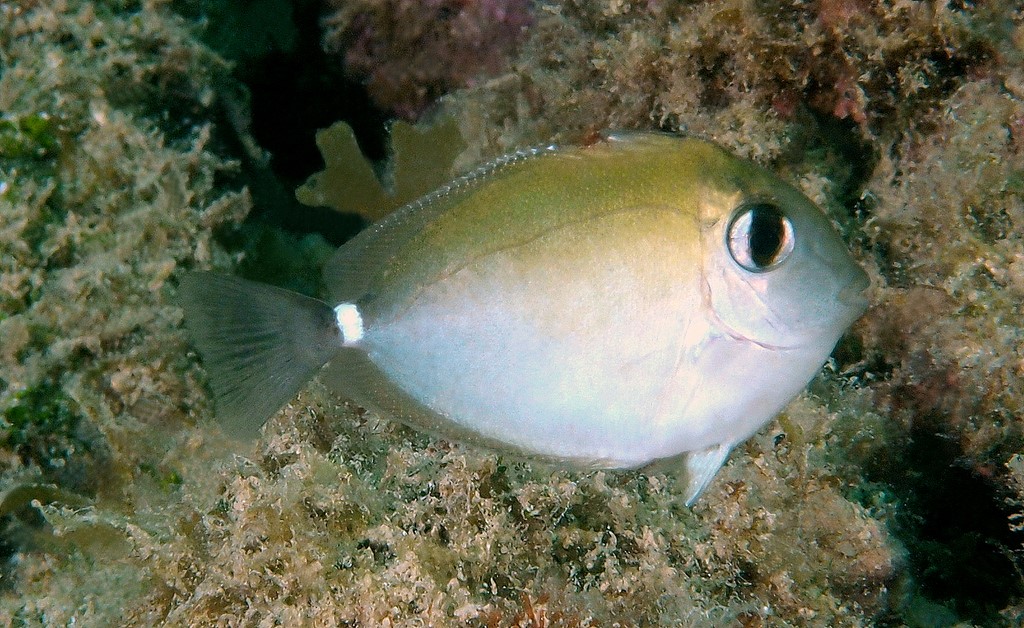NASO ANNULATUS - (QUOY & GAIMARD, 1825)
Actinopterygii (Gigaclass) > Actinopteri (Class) > Teleostei (Subclass) > Acanthuriformes (Order) > Acanthuridae (Family) > Naso (Genus)
Nason à bordures blanches, Short-horned unicorn-fish, Ringtailed unicornfish, White margin unicornfish, White-margin unicorn, Whitemargin unicornfish, Witrand-eenhoringvis, Hvidkantet næsehornsfisk, Weißband-Nashornfisch, Rufia anelar, Hime-tenguhagi, ヒメテングハギ, 环纹鼻鱼, 剥皮仔, 環紋鼻魚, Cá một sừng sọc, أبو قرن, تک شاخ ماهی سفید,
Synonymes
Acanthurus incipiens (Jenkins, 1903)
Naso herrei (Smith, 1966)
Naseus marginatus (Valenciennes, 1835)
Priodon annularis (Valenciennes, 1835)
Priodon annulatus (Quoy & Gaimard, 1825)
-----------------------
Nason à bordures blanches, Short-horned unicorn-fish, Ringtailed unicornfish, White margin unicornfish, White-margin unicorn, Whitemargin unicornfish, Witrand-eenhoringvis, Hvidkantet næsehornsfisk, Weißband-Nashornfisch, Rufia anelar, Hime-tenguhagi, ヒメテングハギ, 环纹鼻鱼, 剥皮仔, 環紋鼻魚, Cá một sừng sọc, أبو قرن, تک شاخ ماهی سفید,
Synonymes
Acanthurus incipiens (Jenkins, 1903)
Naso herrei (Smith, 1966)
Naseus marginatus (Valenciennes, 1835)
Priodon annularis (Valenciennes, 1835)
Priodon annulatus (Quoy & Gaimard, 1825)
-----------------------
Description
Dorsal spines (total): 5; Dorsal soft rays (total): 28-29; Anal spines: 2; Anal soft rays: 27-28; Pectoral fin rays: 17-19; Pelvic fin rays I, 3; Body depth about: 2.2 in SL of subadults to about: 2.8 in SL in large adults. Adults with a long tapering bony horn anterior to eye which can project as much as a head length in front of mouth; Subadults of about 20.0 cm show the beginning of the horn as a bump in front of lower edge of eye; Profile of snout to base of horn about: 60°; Two peduncular plates, each developing a knife-like keel in adults; Caudal fin of subadults truncate, of adults scalloped, some (believed to be males) developing a long filament from each corner. Max. length: 100.0 cm TL. Depth range: 1 - 60 m, usually: 25 - 60 m.
Color
The species is brown to grey or blackish. Juveniles often have a white ring around the caudal peduncle. The caudal fin margin and membranes of adults are white. subadults with black caudal rays, narrow margins and white caudal filaments; Pectoral fins with white distal margins.
Etymology
Naso: from Latin, nasus = nose. Referring to “protuberance in the shape of a horn or a large magnifying glass on the nose” (translation, actually forehead) on adults of Naso fronticornis (= unicornis).
annulatus: from Latin, annulus = ring. Referring to white ring around (or saddle across) caudal peduncle of juveniles.
Original description: Priodon annulatus Quoy & Gaimard, 1825 - Type locality: Timor Island, southern Malay Archipelago, Timor Sea, eastern Indian Ocean.
Distribution
Red Sea, Indo-West Pacific: East Africa, Socotra, Madagascar, Seychelles and Mascarenes east to Hawaiian Islands, Marquesas Islands and Gambier Islands, north to southern Japan, south to Western Australia, Queensland (Australia), New Caledonia, Lord Howe Island, Norfolk Island, and Tonga; Also at Clipperton Island in eastern Pacific.
Biology
Juveniles occur in clear, shallow lagoon reefs; Adults encountered off outer reef drop-offs in small schools. Benthopelagic. Feeds on large zooplankton during the day and shelter within the reef during the night; Also benthic algae. Spawn in pairs. Reports of ciguatera poisoning.
Similar species
Naso brachycentron (Valenciennes, 1835) - Reported from New Caledonia. Distinctive humped back; Horn only in adult males. A few scattered small dark-edged pale spots on postorbital head and body above pectoral fins. No white margin posteriorly on caudal fin.
Naso brevirostris (Cuvier, 1929) - Reported from New Caledonia - Link to the species (here). Adults bluish grey to olivaceous brown in color, commonly pale anteriorly and on cheek and throat.
Last update: 10, May 2022
Dorsal spines (total): 5; Dorsal soft rays (total): 28-29; Anal spines: 2; Anal soft rays: 27-28; Pectoral fin rays: 17-19; Pelvic fin rays I, 3; Body depth about: 2.2 in SL of subadults to about: 2.8 in SL in large adults. Adults with a long tapering bony horn anterior to eye which can project as much as a head length in front of mouth; Subadults of about 20.0 cm show the beginning of the horn as a bump in front of lower edge of eye; Profile of snout to base of horn about: 60°; Two peduncular plates, each developing a knife-like keel in adults; Caudal fin of subadults truncate, of adults scalloped, some (believed to be males) developing a long filament from each corner. Max. length: 100.0 cm TL. Depth range: 1 - 60 m, usually: 25 - 60 m.
Color
The species is brown to grey or blackish. Juveniles often have a white ring around the caudal peduncle. The caudal fin margin and membranes of adults are white. subadults with black caudal rays, narrow margins and white caudal filaments; Pectoral fins with white distal margins.
Etymology
Naso: from Latin, nasus = nose. Referring to “protuberance in the shape of a horn or a large magnifying glass on the nose” (translation, actually forehead) on adults of Naso fronticornis (= unicornis).
annulatus: from Latin, annulus = ring. Referring to white ring around (or saddle across) caudal peduncle of juveniles.
Original description: Priodon annulatus Quoy & Gaimard, 1825 - Type locality: Timor Island, southern Malay Archipelago, Timor Sea, eastern Indian Ocean.
Distribution
Red Sea, Indo-West Pacific: East Africa, Socotra, Madagascar, Seychelles and Mascarenes east to Hawaiian Islands, Marquesas Islands and Gambier Islands, north to southern Japan, south to Western Australia, Queensland (Australia), New Caledonia, Lord Howe Island, Norfolk Island, and Tonga; Also at Clipperton Island in eastern Pacific.
Biology
Juveniles occur in clear, shallow lagoon reefs; Adults encountered off outer reef drop-offs in small schools. Benthopelagic. Feeds on large zooplankton during the day and shelter within the reef during the night; Also benthic algae. Spawn in pairs. Reports of ciguatera poisoning.
Similar species
Naso brachycentron (Valenciennes, 1835) - Reported from New Caledonia. Distinctive humped back; Horn only in adult males. A few scattered small dark-edged pale spots on postorbital head and body above pectoral fins. No white margin posteriorly on caudal fin.
Naso brevirostris (Cuvier, 1929) - Reported from New Caledonia - Link to the species (here). Adults bluish grey to olivaceous brown in color, commonly pale anteriorly and on cheek and throat.
Last update: 10, May 2022
